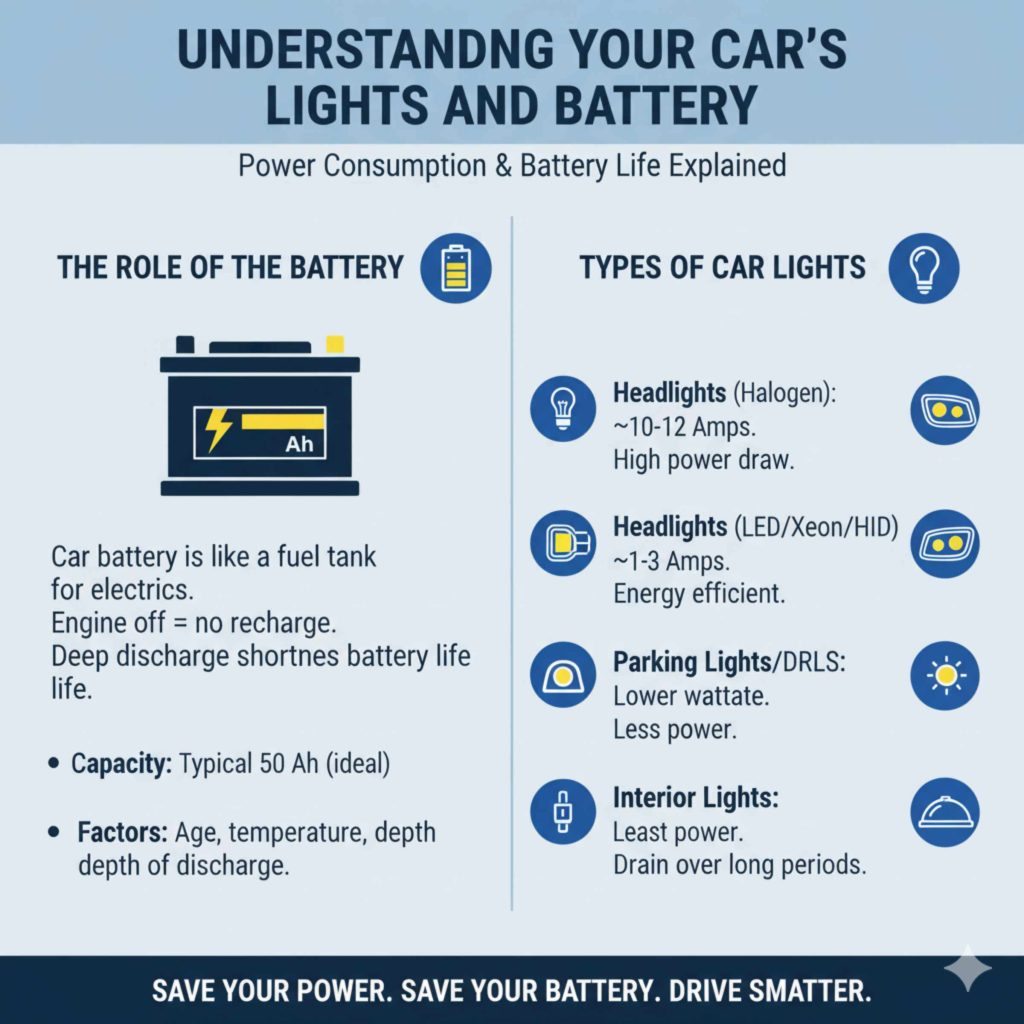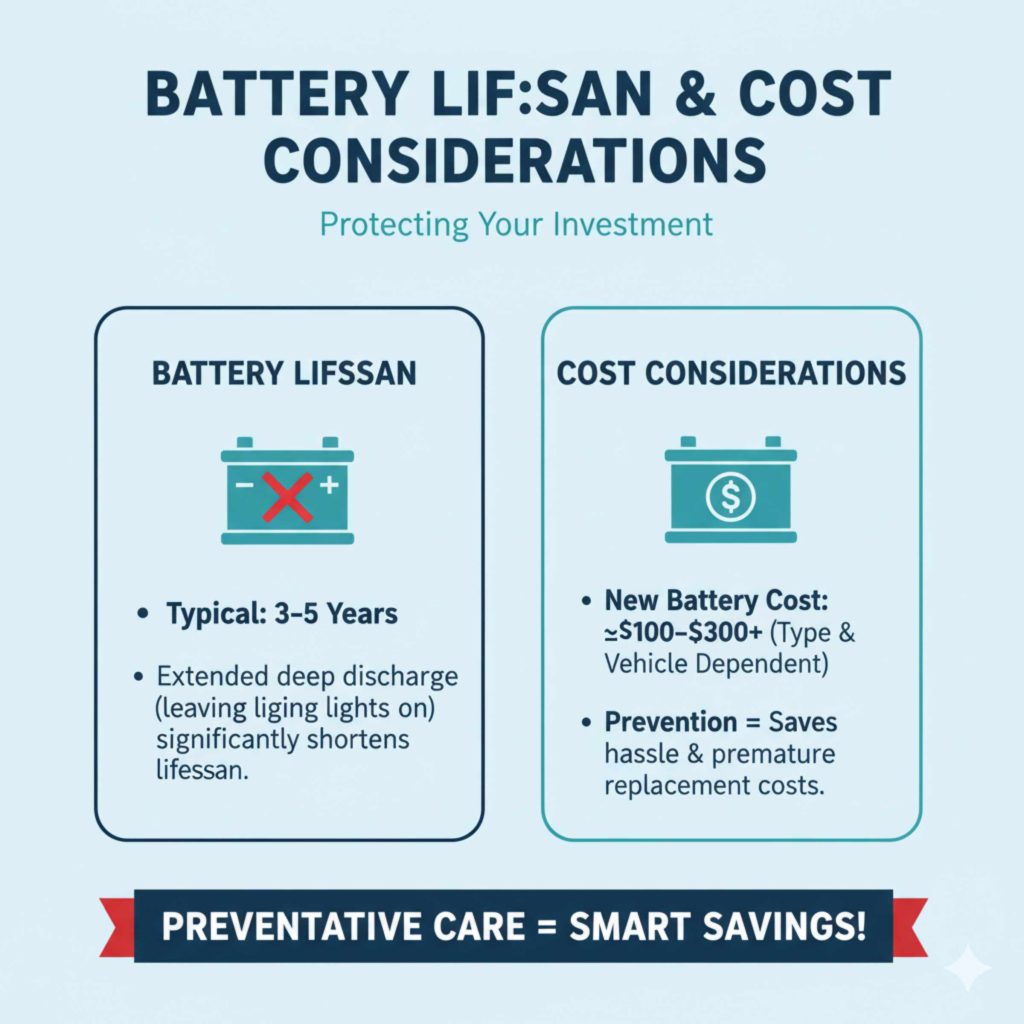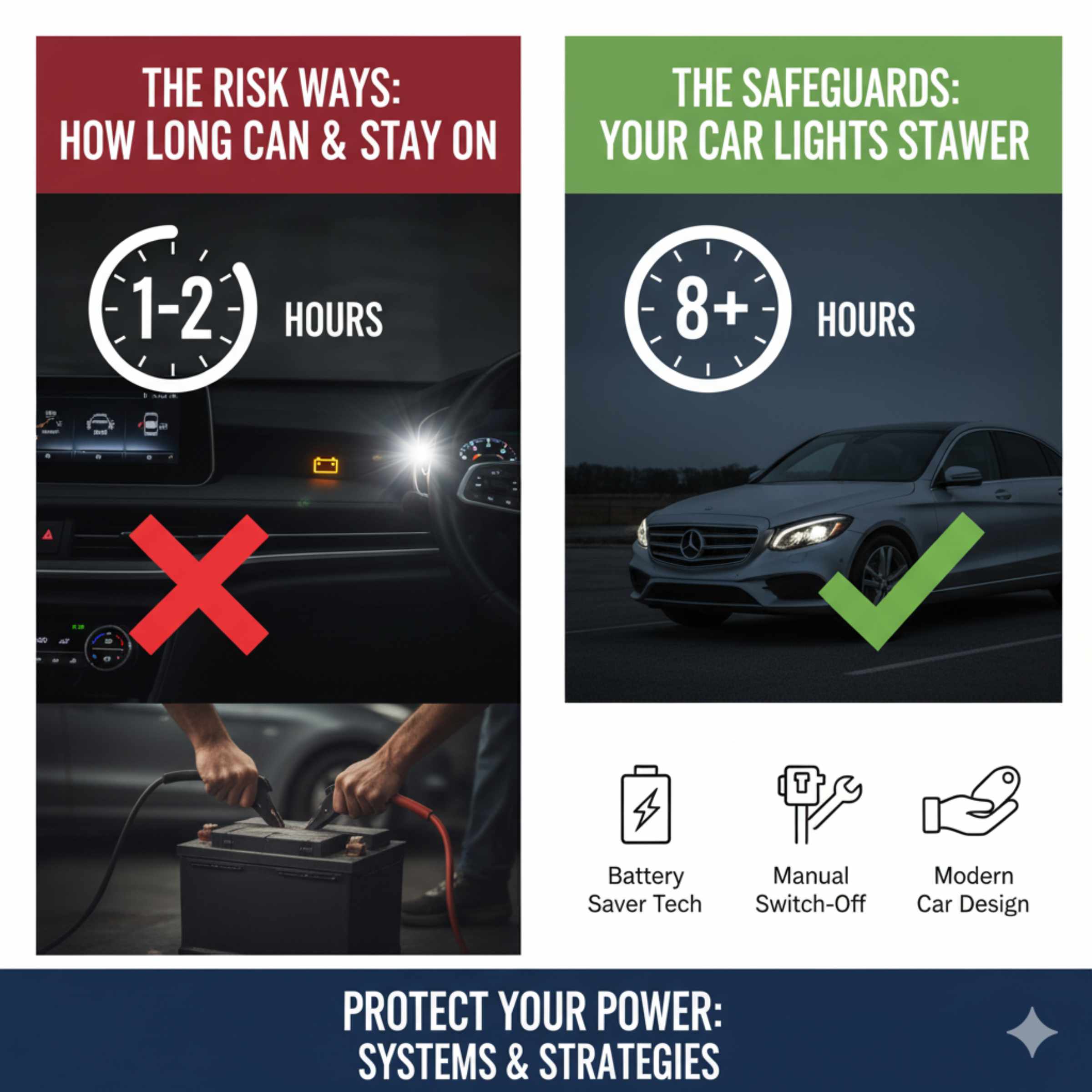Your car’s headlights can typically stay on for about 1 to 4 hours before draining the battery, depending on the type of lights, battery condition, and whether the engine is running. Modern LEDs are more efficient than older halogens. Always check your owner’s manual for specifics.
Ever accidentally left your car lights on all night? It’s a sinking feeling, right? You go to start your car, and… nothing. Just a sad click or silence. This is a super common problem, and it’s usually because the car lights were left on for too long, completely draining the battery. But exactly how long is too long? Understanding this can save you from a dead battery and a lot of stress. We’ll break down how long your car lights can stay on before they cause trouble, what factors play a role, and what you can do to prevent it.
Understanding Your Car’s Lights and Battery
Your car’s lighting system is designed to be used when the engine is running. When the engine is off, the lights draw power directly from the battery, which is your car’s portable power source. Think of the battery like a fuel tank for your car’s electrical system. When the engine is off, there’s no alternator to refill that tank.
The Role of the Battery
Car batteries are rated in amp-hours (Ah), which tells you how much current they can deliver over time. A typical car battery might be around 50 Ah. This means, theoretically, it could provide 1 amp for 50 hours or 5 amps for 10 hours. However, this is an ideal scenario. In reality, factors like battery age, temperature, and how deeply it’s discharged affect its actual capacity. Discharging a car battery too deeply can also shorten its lifespan.
Types of Car Lights
Different lights use different amounts of power:
Headlights (Halogen): These are the traditional bulbs and are relatively power-hungry. A pair of low-beam halogen headlights can draw around 10-12 amps.
Headlights (LED/Xenon/HID): Newer vehicles often use LED, Xenon, or High-Intensity Discharge (HID) lights. These are significantly more energy-efficient. LEDs can use as little as 1-3 amps per light, making them much kinder to your battery when the engine is off.
Parking Lights/Daytime Running Lights (DRLs): These are usually lower wattage and draw less power than headlights.
Interior Lights: Dome lights and vanity mirror lights are generally the least power-intensive but can drain a battery if left on continuously for a very long time.

How Long Can Your Car Lights Stay On Before the Battery Dies?
Here’s the crucial question, and the answer isn’t a single number. It depends on several factors.
General Estimates for Headlights
Let’s assume a standard car with a healthy, fully charged battery (around 50 Ah) and conventional halogen headlights.
Low Beams: A pair of low-beam headlights uses about 10 amps. If your battery has a usable capacity of, say, 40 Ah (leaving some buffer to protect the battery), you could theoretically run them for about 4 hours (40 Ah / 10 amps = 4 hours).
High Beams: High beams use slightly more power, perhaps 15 amps. This would reduce the time to around 2.5 hours (40 Ah / 15 amps = ~2.67 hours).
However, this is a simplified calculation. In reality, you might only have 1 to 2 hours before you start experiencing serious battery drain, especially if the battery isn’t in peak condition or if temperatures are cold.
What Affects the Time?
Several things change how long your lights can stay on:
Battery Age and Health: An older battery or one that hasn’t been maintained well will have less capacity. A battery that is already partially discharged due to short trips or cold weather will die even faster.
Type of Lights: As mentioned, LED headlights are far more efficient. If your car has LED DRLs or headlights, they might stay on for 10+ hours, or even indefinitely without significantly impacting the battery, simply because they use a fraction of the power.
Temperature: Cold weather reduces a battery’s cranking power and its effective capacity. In freezing temperatures, your available battery power can drop significantly.
Other Electrical Devices: If you have other accessories running (radio, interior lights, alarm system), they also draw power from the battery, shortening the time the headlights can be on.
Engine Running vs. Off: When the engine is running, the alternator recharges the battery. This is why you can have your headlights on for hours while driving without issue. The question is specifically about when the engine is OFF.
Here’s a table to give you a rough idea, keeping in mind these are estimates:
| Light Type | Estimated Draw (Amps per light) | Total Draw (Amps) | Estimated Duration (Healthy Battery) |
| :—————————– | :—————————— | :—————- | :———————————– |
| Halogen Low Beams (Pair) | 5-6 | 10-12 | 1-4 hours |
| Halogen High Beams (Pair) | 7-8 | 14-16 | 1-3 hours |
| LED Headlights (Pair) | 1-2 | 2-4 | 10+ hours (often much longer) |
| Daytime Running Lights (DRLs) | 1-3 | 2-6 | 8+ hours (often much longer) |
| Incandescent Interior Light | 0.5-1 | 0.5-1 | 20+ hours |
| LED Interior Light | 0.1-0.3 | 0.1-0.3 | 50+ hours (often much longer) |
Important Note: These are general estimates. Always refer to your car’s owner’s manual for specific information about your vehicle’s battery and electrical system. For more technical details on battery testing and health, the BatteryStuff Knowledge Base offers in-depth guides.
Common Scenarios and How Long They Last
Let’s look at some typical situations where lights might be left on.
Scenario 1: Headlights Left On Overnight
This is the classic scenario. If your car has standard halogen headlights and your battery is reasonably healthy, leaving them on for 8 hours overnight will almost certainly drain enough power to prevent your car from starting. You’re likely looking at a dead battery. If you have efficient LEDs, you might wake up to a perfectly fine car.
Scenario 2: Interior Light Left On During a Movie
If you leave a powerful incandescent dome light on for a 2-3 hour movie, you could potentially drain enough power to make starting your car difficult, especially if the battery is older or the weather is cold. Modern LED interior lights are much less of a concern.
Scenario 3: Daytime Running Lights Left On
Many modern cars have DRLs that automatically turn off when the engine is shut off. However, if yours don’t, or if you accidentally leave other lights on with the DRLs, their lower power consumption means they are less likely to kill your battery as quickly as headlights.
Will My Car Warn Me?
Some cars have built-in warnings to prevent you from leaving the lights on.
Audible Chimes: Many vehicles will emit a chime or beep if you open the driver’s door with the headlights on and the engine off. This is a great reminder!
Automatic Shut-off: Some cars are designed to automatically turn off headlights after a set period (e.g., 10-30 minutes) if the engine is off, to prevent battery drain. Check your owner’s manual to see if your car has this feature.
Dashboard Reminders: Some cars will display a warning light or message on the dashboard.
However, not all cars have these features, and even when they do, they might not be foolproof. The best defense is awareness.
What Drains The Battery Besides Lights?
It’s not just lights that can drain your car’s battery when the engine is off. Here are some other culprits:
Ignition Systems: Leaving the key in the “Accessory” (ACC) position allows you to power the radio, but it also draws power from the battery.
Aftermarket Accessories: Alarms, stereos, dashcams, and charging devices that are not properly installed or that have a “parasitic draw” can slowly drain the battery. A healthy parasitic draw should be very low (typically under 50 milliamps). If it’s higher, it needs to be diagnosed.
Faulty Electronics: Malfunctioning modules or relays can stay “awake” and draw power even when they shouldn’t.
Leaving Doors Ajar: This can keep interior lights and sometimes other systems active.
How To Prevent Leaving Your Car Lights On
Prevention is always better than a cure! Here are some easy tips:
1. Get Into the Habit of Checking
Before you turn off the engine: Take a quick glance at your dashboard and the front of your car. Are the headlights on?
As you exit the vehicle: Pause for a second. Did you hear any chimes? Is the light on the dashboard indicating headlights are on?
2. Utilize Automatic Light Features
Automatic Headlights: Many cars have a setting that turns headlights on and off automatically based on ambient light. Make sure this is enabled if your car has it.
Automatic Shut-off: If your car has an automatic shut-off feature for lights, always ensure it’s functional.
3. Read Your Owner’s Manual
Your owner’s manual is the best resource for understanding your specific vehicle’s features, including how its lighting system works and any battery-saving functions it might have. You can often find a PDF version online if you’ve misplaced the physical copy. For example, NHTSA provides excellent resources on how to find and utilize your vehicle’s manual.
4. Install a Battery Minder or Cut-Off Switch (Advanced)
For those who frequently worry about this or have older vehicles without modern safeguards, you can explore installing a battery minder or a manual battery cut-off switch. These are more advanced options and might require professional installation.
5. Understand Your Car’s Chimes and Warnings
Get to know the sounds and dashboard lights your car uses to alert you. Often, a simple beep is there to save you from a major headache.
What To Do If Your Car Lights Stayed On (and Now It Won’t Start)
Don’t panic! This is a fixable situation.
Step 1: Identify the Problem
If your car makes a clicking sound or no sound at all when you try to start it, and you suspect the lights were left on, a dead battery is the most likely cause.
Step 2: Get a Jump Start
This is the most common solution. You’ll need:
Jumper Cables: Ensure they are in good condition.
Another Vehicle: A car with a working battery.
Knowing How to Jump Start Safely: It’s crucial to connect the cables correctly to avoid sparks or damage to either vehicle’s electrical system.
Here’s the safest way to jump-start:
- Position the Cars: Park the working car close enough to the dead car so the jumper cables reach, but without touching. Turn off both vehicles and ensure their parking brakes are engaged.
- Connect the Red Cable: Attach one red clamp to the positive (+) terminal of the dead battery. Attach the other red clamp to the positive (+) terminal of the good battery.
- Connect the Black Cable: Attach one black clamp to the negative (-) terminal of the good battery.
- Ground the Last Clamp: Attach the final black clamp to a clean, unpainted metal surface on the engine block or chassis of the dead car, away from the battery. This helps prevent sparks near the battery fumes.
- Start the Working Car: Let it run for a few minutes to charge the dead battery.
- Try Starting the Dead Car: Attempt to start the car with the dead battery. If it doesn’t start, wait a few more minutes with the working car running and try again.
- Disconnect Cables (in Reverse Order): Once the dead car is running, carefully disconnect the cables in the reverse order they were connected: black from the engine block, black from the good battery, red from the good battery, red from the dead battery.
- Keep it Running: Drive the car for at least 20-30 minutes to allow the alternator to recharge the battery adequately.
For a visual guide and extra safety tips, check out resources like HowStuffWorks’ detailed instructions on jump-starting a car.
Step 3: Check Your Battery’s Condition
If your battery dies frequently due to lights or other issues, it might be time for a professional check. A mechanic can test your battery’s health and capacity. If it’s old or failing, replacement might be necessary.
Step 4: Look for Parasitic Draw
If your battery dies without you leaving lights on, or if it dies again soon after a jump start, you might have a parasitic draw – something is using power when it shouldn’t be. A mechanic can diagnose this.
Battery Lifespan and Cost Considerations
A car battery typically lasts between 3 to 5 years. Leaving lights on for extended periods can significantly shorten this lifespan by over-discharging it. A new car battery can cost anywhere from $100 to $300 or more, depending on the type and your vehicle. Preventing a dead battery saves you the immediate hassle and potentially the cost of premature replacement.

Frequently Asked Questions (FAQ)
Q1: Can leaving my headlights on kill my car battery completely?
Yes, absolutely. If your headlights (especially older halogen types) are left on for a few hours, they can drain enough power from your battery to prevent your car from starting. This is a very common reason for a dead car battery.
Q2: How long can LED headlights stay on without draining the battery?
LED headlights are significantly more energy-efficient than traditional halogen bulbs. They can often stay on for many hours, sometimes even overnight, without completely draining a healthy car battery. The exact time depends on the LED’s wattage and the battery’s condition.
Q3: What’s the difference between leaving lights on and a parasitic draw?
Leaving lights on is an intentional (though accidental) draw of power from the battery when the engine is off. A parasitic draw is when an electrical component or system in your car is using power when it shouldn’t be, even after the car is turned off and all expected systems are dormant. This is often caused by faulty electronics or aftermarket accessories.
Q4: My car beeped when I opened the door, but the lights were on. Is that enough warning?
That beep is a helpful warning sound! It means your car is trying to tell you the lights are on and could drain the battery. Always pay attention to these chimes and double-check your lights before leaving the vehicle.
Q5: How can I tell if my car battery is about to die?
Signs include slow engine cranking when you start the car, dim headlights or interior lights, and electrical issues like power windows moving slower than usual. If your car has needed jump-starts recently, or if the battery is over 3-5 years old, it might be nearing the end of its life.
Q6: Is it bad to jump-start my car?
Jump-starting is a safe and effective way to get a car with a dead battery started if done correctly. However, if your battery dies frequently, it suggests an underlying problem like a faulty battery, alternator, or a parasitic draw that needs to be fixed.
Conclusion
Knowing how long your car lights can stay on is pretty straightforward once you understand the key factors. For older cars with halogen lights, a few hours is usually the limit before you risk a dead battery. Newer cars with LED lights offer much more forgiveness. The best strategy is always prevention: develop a habit of checking your lights before you leave your car, utilize any automatic features your vehicle has, and be aware of any warning chimes. If you do find yourself with a dead battery, a jump-start is a common fix, but don’t ignore recurring issues – they often point to a need for battery maintenance or repair. By staying aware and taking simple precautions, you can ensure your car is ready to go when you are, saving you time, money, and peace of mind.

